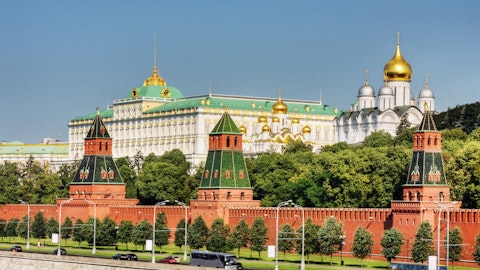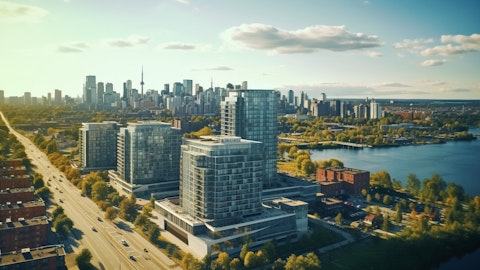In this piece, we are going to discuss upon 15 Countries Where Much or Most of Population Lives in Cities, also taking into account the urbanization dynamics globally. If you want to skip all the detailed analysis of ours, you can go directly to 5 Countries Where Much or Most of Population Lives in Cities.
It is projected that urban populations worldwide will increase to 80% by 2050, up from the current 55%. Global material consumption is anticipated to more than double to approximately 89 billion tonnes, as reported by the UN International Resource Panel. The wealthiest nations consume 10 times more than the poorest, with consumption rates in Asia and Africa expected to grow rapidly until 2050.
Developing low-carbon and resource-efficient cities can help alleviate the negative effects of increased material consumption, including pollution and carbon emissions. Despite covering only 2% of the Earth’s land, cities utilize over 75% of the planet’s material resources. Urban expansion is forecasted to escalate global material consumption from 41.1 billion tonnes in 2010 to around 89 billion tonnes by 2050. The majority of urban growth, according to the UN, will occur in Global South cities, particularly in China, India, and Nigeria. Asia is projected to experience a significant rise in consumption due to its high concentration of megacities (cities with over 10 million inhabitants). However, the most substantial growth is anticipated in Africa over the next few decades. The continent’s population is expected to double by 2050, with material consumption skyrocketing from 2 billion tonnes to 17.7 billion tonnes annually.
Most countries with the lowest urban populations are situated in Africa. Despite their low urban population percentages, several of these countries are undergoing rapid urbanization. For instance, Burundi has an urban population of 14.4%, which is relatively low, but it has the world’s highest urbanization rate at 5.43%. Similarly, Uganda’s urban population stands at 26.2%, while its urbanization rate is 5.41%. These countries are often classified among the least developed or underdeveloped nations globally.
With the growing population across the world, there’s a direct impact on the global food market in the world. As the world’s population grows and urbanizes, the consumer food industry is facing some major supply chain hurdles, price hikes, and changing consumer preferences. This situation has led to increased costs, operational disruptions, and challenges in labor and procurement. However, it has also opened up new possibilities for companies to innovate and expand by introducing fresh products and top-notch services. The global consumer-packaged foods market is worth around $1.1 trillion currently in 2024, and is expected to hit $1.6 trillion by 2030.
Amidst this, and before we move on to our list of 15 Countries Where Much or Most of Population Lives in Cities, it’s significant to see what great businesses food companies are doing all across the world. Namely, we are going to discuss PepsiCo, Inc. (NASDAQGS:PEP), The Coca-Cola Company (NYSE:KO) and McDonald’s Corporation (NYSE:MCD).
PepsiCo, Inc. (NASDAQGS:PEP)
PepsiCo, Inc. (NASDAQGS:PEP) is a big American company that sells food, snacks, and drinks. It’s based in Harrison, New York, near Purchase. PepsiCo manages everything from making its products to getting them out there to customers. In the last quarter, they made $1.3 billion in profit, with earnings of 94 cents per share. Their sales were a bit lower than expected at $27.85 billion. This is the first time since 2020 that their sales dropped from the previous year, partly due to exchange rates and having an extra week in the prior year.
The Coca-Cola Company (NYSE:KO)
The Coca-Cola Company (NYSE:KO) is a fizzy drink made by the Coca-Cola Company. They sell their drinks all over the world, with people guzzling down more than 1.8 billion of their beverages daily in 2013. Coke is aiming for 6% to 7% organic sales growth in 2024, which is a bit higher than Pepsi’s target of 4%. They’re also expecting their earnings to rise faster than their revenue, which could help them maintain their strong profit margin of nearly 30% of sales.
McDonald’s Corporation (NYSE:MCD)
McDonald’s Corporation (NYSE:MCD), a big American fast-food chain, started back in 1940 in San Bernardino, California, by the McDonald brothers. It’s super popular with families and kids all around the world. After experiencing some amazing sales growth for three years, McDonald’s seems to be cooling down a bit. The burger giant, based in Chicago now, predicts their sales at existing locations will go up by 3% to 4% this year, which is around their usual average. This is a drop from the huge jumps they saw in 2021 and 2022, as well as the 9% growth last year.

An aerial view of a suburban community, with residential homes stretching into the horizon.
Methodology
To create our list 15 Countries Where Much or Most of Population Lives in Cities, we referred to the urbanization rate of the countries, as provided by the World Population Review, as in 2024. For the countries with equal urbanization rates, we ranked them on the basis of total population, furthering the extent of urbanization measure of the country. Also, please note that all population figures mentioned pertain to 2024, except mentioned otherwise. With this, let’s now jump to our list of Countries Where Much or Most of Population Lives in Cities.
By the way, Insider Monkey is an investing website that tracks the movements of corporate insiders and hedge funds. By using a similar consensus approach, we identify the best stock picks of more than 900 hedge funds investing in US stocks. The top 10 consensus stock picks of hedge funds outperformed the S&P 500 Index by more than 140 percentage points over the last 10 years (see the details here). Whether you are a beginner investor or professional one looking for the best stocks to buy, you can benefit from the wisdom of hedge funds and corporate insiders.
15. Lebanon
Urbanization Rate 2024: 89.40%
With a population of 5.3 million, Lebanon has faced numerous crises, including an influx of 1.5 million refugees since 2011, straining public services. Urban areas, where many refugees settle, are hit hardest. Challenges like the COVID-19 pandemic, economic collapse, currency devaluation, and Beirut explosions have pushed 74% of the population into poverty. Civil unrest and protests over government corruption have worsened the situation, leading to a banking system crisis and currency devaluation. Addressing these issues is crucial, especially in urban areas where 90% of the population lives, to ensure everyone has access to basic services and rights.
14. Bahrain
Urbanization Rate 2024: 89.90%
With a population of 1.5 million people, Bahrain ranks ninth among the top destinations worldwide for expatriates thanks to its easy visa process, smooth dealings with local authorities, and hassle-free bank account setup. Bahrain took the top spot in the Expat Essentials Index, covering housing, bureaucracy, language, and digital resources. The UAE and Saudi Arabia landed second and ninth places, respectively.
13. Gabon
Urbanization Rate 2024: 91.00%
With a population of 2.5 million, Gabon has a wealth of natural resources like timber, manganese, and oil. It’s the fifth biggest oil producer in Africa, which played a key role in its solid growth in the latter part of the 20th century. Currently, the oil industry makes up half of Gabon’s GDP and a whopping 80% of its exports.
12. Jordan
Urbanization Rate 2024: 92.00%
Jordan has a population of 11.4 million. In Jordan, the rural population has stayed pretty low for almost 70 years, and it’s been slowly decreasing since the mid-2000s, a trend that’s expected to keep going. The urban population surpassed the rural one for the first time back in 1960, and it’s been steadily skyrocketing ever since. This surge in urban populations is expected to continue in the coming decades.
11. Japan
Urbanization Rate 2024: 92.00%
Japan, with a population of whopping 123 million, is super packed with people in its cities, making it one of the most urbanized places globally. Out of its 47 prefectures, only 7 have a population under 1 million. After the Tokyo earthquake in 1923, the buildings in Tokyo initially showed Western influences, but eventually, they stuck to their own design style. Tokyo and other Japanese cities expanded slowly through land readjustment, without any grand boulevards or fancy monuments. Now, Japan is kicking butt in the world of architectural design!
10. Argentina
Urbanization Rate 2024: 92.50%
Taking up a huge chunk of land in the southern part of South America, Argentina, with a population of 46 million, boasts the second-largest economy on the continent, with a GDP around $1 trillion, as at the end of 2023. The country is blessed with abundant natural resources and excels in beef and cereal production. Argentina is a hot spot for adventure tourism and has a top-notch IT sector.
9. Israel
Urbanization Rate 2024: 92.90%
With a total population of 9.3 million, around 92% of Israelis reside in urban areas. Several contemporary towns and cities, merging ancient and modern elements, are constructed on historically significant sites, such as Jerusalem, Safed, Be’er Sheva, Tiberias, and Akko.
8. Netherlands
Urbanization Rate 2024: 93.20%
Netherlands has a population of 17.7 million. The biggest urban bunch in the Netherlands is called Randstad, which includes the top four cities: Amsterdam, Rotterdam, The Hague, and Utrecht. Among these, three have been granted historical city privileges: Utrecht since 1122, Amsterdam since 1306, and Rotterdam since 1340.
7. Puerto Rico
Urbanization Rate 2024: 93.60%
For over 400 years, Puerto Rico, home to 3.3 million people, has relied heavily on agriculture for its economy. However, changes in society and politics in the early 20th century led to a move toward industry. This shift, along with a growing population, has led to the expansion of urban areas. Even though poverty has decreased in Puerto Rico and the most poverty-stricken states over the past 50 years, Puerto Rico still faces significantly high levels of poverty compared to its historical trends and other areas.
6. Uruguay
Urbanization Rate 2024: 95.80%
The most recent census in Uruguay shows that over 95% of the population resides in cities, out of 3.4 million total population. This urban living trend has been a longstanding feature of the country and is projected to grow in the future. That’s why Uruguay has decided to concentrate its National Adaptation Plan (NAP-Cities) efforts on urban areas, where essential services and key economic activities are centered. Creating a National Adaptation Plan for Cities and Infrastructures (NAP-Cities) is a fresh initiative at the national level to blend adaptation strategies into city planning and infrastructure development at both the national and local levels in Uruguay.
Click to continue reading and find out about the 5 Countries Where Much or Most of Population Lives in Cities.
Suggested Articles:
- 25 Countries where Muslim Population will Increase the Most by 2030
- 20 States with the Oldest Population in the US
- 20 Countries with the Highest Homeless Population
Disclosure: None. 15 Countries Where Much or Most of Population Lives in Cities is originally published on Insider Monkey.





